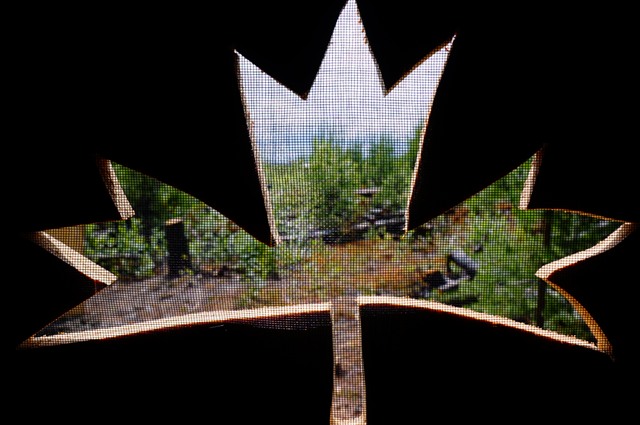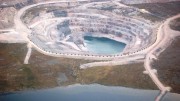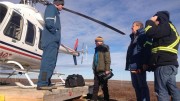After going into hibernation in the wake of the Great Recession, diamond juniors are slowly rousing and getting back into the field.
Inspired by Kennady Diamonds’ (TSXV: KDI) success at its Kennady North project, new Canadian diamond mines that are being financed and built, solid rough diamond prices, and a looming supply/demand gap, at least ten companies have staked land or made deals to acquire diamond projects in Canada over the past year or so.
While the overall picture for diamonds is positive, the interest is surprising, as the wider exploration sector remains in the dumps.
But Mike Powers, the CEO of Proxima Diamonds, a diamond prospect generator that expects to list before the end of year through a merger with Adent Capital (TSXV: ANT.P), sees cause for hope.
“I think the market has begun to appreciate the value of exploration,” Power says, pointing to Kennady Diamonds’ success.
“It’s risky, but the opportunity is there in diamonds in the NWT right now. You have four operating mines with mills and infrastructure, so a ready market for product and for resources,” he adds. “The area has an excellent database — it’s only been explored for 20 years. . . so all the pieces I think are in place for new discoveries to be made and exploited.”
The new wave of diamond explorers is seeking to lower the cost and risk associated with Arctic diamond exploration by capitalizing on work that’s already been done. Existing data collected over the past two decades are key to their exploration strategies.
Proxima, for example, is using GGL Resources’ (TSXV: GGL) extensive database, while Randy Turner’s Canterra Minerals (TSXV: CTM) has a proprietary database compiled over 15 years of exploration in the southern Slave province.
“Unlike back in the nineties, when we went out and staked huge blocks of land, we are now target-specific because we’ve narrowed it down based on mineral trains and airborne geophyics,” Turner said in an interview in June.
Turner, whose Winspear Diamonds discovered the Snap Lake mine (now owned by De Beers), announced his return to diamonds in April.
Diamond explorers are also seeking ground close to existing mines where even small-scale discoveries have a chance of being rewarded.
Margaret Lake Diamonds (TSXV: DIA), which started trading in April, has picked up land near De Beers’ and Mountain Province Diamonds’ (TSX: MPV; NYSE-MKT: MDM) Gahcho Kué mine, which is under construction, and Kennady Diamonds’ adjacent project.
“What we’re looking at up there is the potential, in theory, for additional feed to other producers,” Margaret Lake president and CEO Paul Brockington told The Northern Miner in June. “In other words, you don’t necessarily need a standalone mine… so the hurdle that you have to get to in terms of tonnage and grade would be different than if you were trying to start from scratch.”
Ken Armstrong, president and CEO of North Arrow Minerals (TSXV: NAR), which last year amassed a portofolio of promising projects that have seen significant investment, says the area-play phenomenon is in the blood of explorers because it often pays off.
“With diamonds, you need land to evaluate things,” Armstrong said in October. “Staking close to existing deposits is not a bad strategy — that’s how Diavik was found.”
Kennady Diamonds
Kennady Diamonds’ Kennady North project, 280 km northeast of Yellownife, in the Northwest Territories, has consistently surpassed expectations since the junior was spun out of Mountain Province Diamonds in mid-2012.
As Kennady has learned more about the geology of the Kelvin and Faraday kimberlites at the project, the expected tonnage of the project has grown to 9 to 12 million tonnes.
Until recently, the grade had also surprised on the upside: a 4.3-tonne sample from Kelvin last year returned 18.57 carats of diamonds for a grade of 4.32 carats per tonne.
However, this fall, a 25-tonne sample from Kelvin returned 44.64 carats of diamonds for a grade of 1.79 carats per tonne. While that grade is still quite high, it disappointed the market and prompted Kennady’s stock to fall by $2.50 to $5.49.
Kennady president and CEO Patrick Evans, however, was pleased with the grade, saying in October that it falls within the company’s previous guidance of 2 carats per tonne. (When the results of last year’s 4.3-tonne sample are combined with the mini-bulk sample, the overall grade rises to 2.16 carats per tonne.)
The Kelvin and Faraday kimberlites lie northeast of the Gahcho Kué kimberlites, along the same structural fault.
Whereas it was previously thought that the kimberlites were principally northeast-trending dyke structures with a small pipe at the north end of Kelvin, the geological picture changed dramatically this year. Drilling has shown that Kelvin is a horizontal-lying, north-plunging, banana-shaped kimberlite tube, with a kimberlite sheet lying to the southwest and the Faraday kimberlite to the northeast. Between Kelvin and Faraday, there’s thought to be a feeder pipe, Evans explains.
“The theory is that, encountering the structural fault, the pipe didn’t erupt at surface, instead — for lack of a more technical phrase — it squirted kimberlite to the southwest into this fault structure, forming the Kelvin pipe,” he says. “Then, as the fault structure thinned towards the southwest, it formed the Kelvin sheet.”
The Kelvin pipe extends for 610 metres along strike and 100 to 200 metres vertically, and is 30 to 50 metres wide. It remains open to the north.
An initial resource estimate for Kelvin is due in mid-2015. The company is also planning to take a 500 to 700-tonne bulk sample next year.
More NWT exploration
Ten kilometres north of Gahcho Kué, Margaret Lake Diamonds is earning up to 70% of the Margaret Lake property. The junior completed an airborne geophysical survey at the project this summer, where previous work has already identified three targets: A286, A294 and Drop Lake.
Margaret Lake also struck a deal in August to option up to 49% of Canterra Minerals’ Marlin project, adjacent to Kennady Diamonds’ land package to the northwest. Till sampling this summer by project operator Canterra recovered a 1-mm by 1-mm by 1.4-mm off-white, modified octahedral diamond. Several indicator minerals were also recovered, and an airborne geophysical survey was conducted on the northern portion of Marlin.
Canterra has several other projects (Hilltop, King, Prism and Gwen) that have seen targeted till sampling this summer within known kimberlite indicator mineral (KIM) trains.
Southeast of and adjacent to Gahcho Kué, Prima Diamonds (TSXV: PMD) (previously Prima Fluorspar) in June picked up the Godpeed Lake project, where there are four kimberlite targets. In August, Prima added the Munn Lake project to its portfolio. The former SouthernEra Resources project is 35 km east of Snap Lake and adjacent to Canterra’s Gwen project, and hosts the diamondiferous Munn Lake sill, diamond-bearing boulders and several unsourced KIM trains.
Prima’s latest acquisition, in October, is in Quebec, north of Stornoway Diamond’s (TSX: SWY) Renard diamond development. A recent regional airborne magnetic survey over the Orion diamond properties identified seven kimberlite targets.
To begin its exploration programs next year, Prima is looking to raise up to $2.5 million.
Proxima Diamonds has assembled a portfolio of 17 properties that host six known kimberlites in the Northwest Territories. The company has three priority targets, including Sancy, north of Dominion Diamond’s (TSX: DDC; NYSE: DDC) Ekati mine, and Hortensia and Tavernier near Gahcho Kué.
Denendah Exploration and Mining, or DEMCo, a Dene First Nations company, has acquired several prospective diamond claims, including seven kimberlite pipes discovered by De Beers. (Canterra’s Gwen surrounds its CL 25 and CL 175 kimberlites). The company is looking for JV partners to advance the projects.
Lastly, North Arrow tested seven targets this year at the Redemption project, 32 km southwest of Ekati, but did not hit kimberlite. The company is earning up 55% of Redemption from Arctic Star Diamonds (TSXV: ADD) and will revisit the project next year.
Saskatchewan
Last year, North Arrow discovered a new diamond district at its 80%-owned Pikoo project in Saskatchewan. (Stornoway Diamond owns the remainder.)
Drilling at PK150, a 10- to 15-metre-wide kimberlite dyke that extends at least 75 metres along strike, delivered exceptional results in November. A 210-kg sample returned 23 commercial-sized diamonds for a grade of 1.34 carats per tonne.
This year, the company completed a $1-million till-sampling program at Pikoo, where four KIM trains have now been identified.
The company plans to conduct follow-up drilling at Pikoo in February.
Since North Arrow’s discovery, Pikoo has spawned its own area play.
In October, Alto Ventures (TSXV: ATV) completed a till-sampling program on its GEFA and Fisher properties, which are adjacent to Pikoo. Alto is earning a 60% interest in the GEFA claims and 100% of Fisher.
Strike Graphite (TSXV: SRK) struck a deal in May to acquire an 80% stake in two land packages in the Sask Craton near Pikoo. The company is merging with Athabasca Nuclear (TSXV: ASC) in an all-share deal that was expected to close in October.
And Regina-based private company GEM Oil completed a till-sampling program on its GEM15 project in the Pikoo district in October.
Nunavut
Over in Nunavut, near Repulse Bay, North Arrow is earning up to 80% of the advanced Qilalugaq project from Stornoway Diamond.
The project already hosts an inferred resource of 26.1 million carats in 48.8 million tonnes grading 0.54 carat per tonne in the Q1-4 kimberlite.
All North Arrow needs now to assess the potential of the 12.5-hectare pipe — the largest of eight kimberlites at Qilalugaq — is the value of the diamonds it contains.
This summer, the junior completed a 1,500-tonne mini-bulk sample at Q1-4 in order to collect a parcel of at least 500 stones for a valuation.
If processing of the bulk sample goes smoothly, the valuation results could be released by the end of the first quarter. Q1-4 could contain a population of fancy yellow stones, which would boost the project’s value.
Peregrine Diamonds’ (TSX PGD) Chidliak project, on Baffin Island, is easily Nunavut’s most advanced diamond project, with 68 kimberlite bodies discovered since 2008.
Peregrine released an inferred resource for the CH-6 kimberlite at Chidliak in May: 7.5 million carats in 2.89 million tonnes grading 2.58 carats per tonne.
The resource extends to 250 metres depth.
The company is working to add resources at CH-6, with a resource update expected before year-end, and to delineate resources at CH-7 and CH-44 on the way to a preliminary economic assessment for Chidliak in 2016.
Bulk samples are planned for CH-6, CH-7 and CH-44 next year.
An initial valuation of a 1,013.5-carat parcel of CH-6 diamonds in February revealed an average price of US$213 per carat. The company expects that CH-7 and CH-44 could host diamonds of similar quality.
In order to advance its bulk-sampling program, Peregrine completed a $15.1-million rights offering priced at 21¢ per unit in October.
While the dilutive financing was controversial, Tom Peregoodoff, Peregrine’s executive vice-president of business development, said that the company had to consider all its options given current market conditions.
“We had a choice to make and it really boiled down to trying to preserve the value of the asset, which is primarily Chidliak, for our current shareholders, or allow new money to come in at what we felt were probably undervalued (market prices),” he said in October.
Chidliak has the potential to be a very high-margin project, with rock value of US$550-600 per tonne at CH-6, he noted.
Also in Nunavut, Churchill Diamond is planning to launch a major program after it lists in early 2015. The company has acquired Diamonds North’s (now Adamera Minerals [TSXV: ADZ]) Amaruk project. Twenty-four of the 30 kimberlites identified on the project, now renamed Pelly Bay, contain diamonds.






Be the first to comment on "Canada’s mini-staking rush"